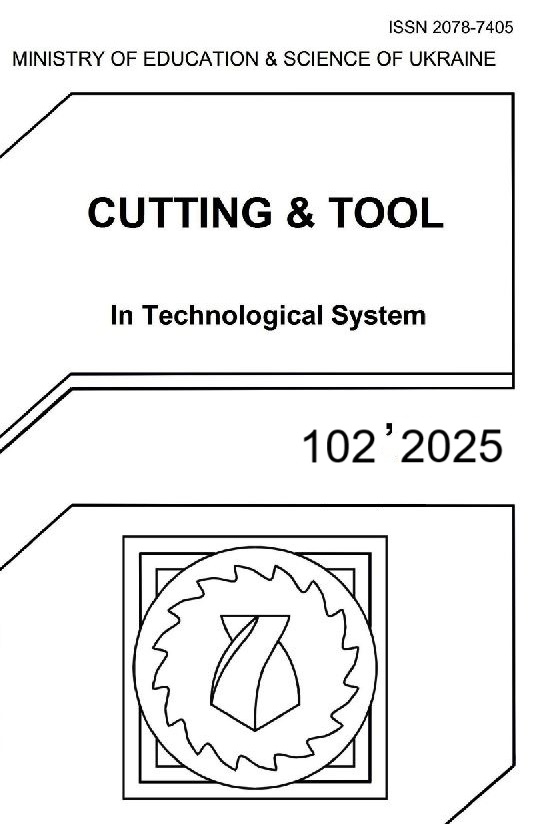PREDICTION OF RESIDUAL DEFORMATIONS IN PRODUCTS MANUFACTURED BY SELECTIVE LASER SINTERING
DOI:
https://doi.org/10.20998/2078-7405.2025.102.06Keywords:
technology planning, selective laser sintering, residual deformation, triangulation models, technological compensating deformationsAbstract
This study addresses the critical challenge of predicting residual deformations in industrial products manufactured using selective laser sintering (SLS) technology. Residual deformations represent one of the primary factors leading to geometric inaccuracies in SLS-produced parts, directly affecting their functional performance and dimensional precision. The research proposes and validates a novel hypothesis that existing prediction models developed for plastic injection molding can be effectively adapted for SLS applications through appropriate conversion factors. Given the absence of specialized tools for SLS deformation prediction in the current market, this approach leverages the mature capabilities of the SOLIDWORKS Plastics software as an alternative solution. The methodology involves creating finite element models of test components, specifying material properties similar to SLS powders, and simulating thermal conditions that mimic the SLS process. Through a comparative analysis of twelve distinct geometries, a significant correlation between predicted deformations and actual measured deformations was established. This coefficient enables reliable translation between simulation results and actual SLS outcomes. The findings demonstrate that technological compensating deformations can be effectively calculated and applied to original triangulation models, substantially reducing geometric deviations in final products. The research bridges the gap between established injection molding simulation techniques and the rapidly evolving field of additive manufacturing, providing a practical approach to enhance dimensional accuracy without requiring specialized SLS deformation prediction software. This research was developed at the Department of "Integrated Technologies of Mechanical Engineering" named after M. Semko of NTU "KhPI".
References
Breuninger, J., Becker, R., Wolf, A., Rommel, S., Verl, A. Generative Fertigung mit Kunststoffen: Konzeption und Konstruktion für Selektives Lasersintern. Springer-Verlag, 2012. 267 p.
Garashchenko Y.M. Udoskonalennya tekhnolohichnoyi pidhotovky adytyvnoho vyrobnytstva skladnykh vyrobiv: monohrafiya. Kharkiv: NTU «KHPI». 2023. 388 p.
Garashchenko, Y., Fedorovich, V., Poharskyi, A., Kozakova, N., Riazanova-Khytrovska, N. Increasing the Accuracy of Part Obtained by Selective Laser Sintering by Shrinkage Compensation. In: Tonkonogyi, V., Ivanov, V., Trojanowska, J., Oborskyi, G. (eds) Advanced Manufacturing Processes VI. Interpartner 2024. Lecture Notes in Mechanical Engineering. Springer, Cham. 2025. pp. 166–177. https://doi.org/10.1007/978-3-031-82746-4_15.
Impey, S.; Saxena, P.; Salonitis, K. Selective Laser Sintering Induced Residual Stresses: Precision Measurement and Prediction. J. Manuf. Mater. Process. 2021, 5, 101. https://doi.org/10.3390/jmmp5030101.
Tian, X., Peng, G., Yan, M., He, S., Yao, R. Process prediction of selective laser sintering based on heat transfer analysis for polyamide composite powders. International Journal of Heat and Mass Transfer, 120, 2018. pp. 379‒386. https://doi.org/10.1016/j.ijheatmasstransfer.2017.12.045.
Sahoo, S. Prediction of residual stress and deformation of build part with variation of hatch spacing in direct metal laser sintering of AlSi10Mg built part: Thermo-mechanical modeling. Journal of Laser Applications, 33(3). 2021. https://doi.org/10.2351/7.0000393.
Chen, Q., Liang, X., Hayduke, D., Liu, J., Cheng, L., Oskin, J., Whitmore, R. and To, A.C. An inherent strain based multiscale modeling framework for simulating part-scale residual deformation for direct metal laser sintering. Additive Manufacturing, 28, 2019. pp. 406‒418. https://doi.org/10.1016/j.addma.2019.05.021.
Li, C., Fu, C.H., Guo, Y.B. and Fang, F.Z., Fast prediction and validation of part distortion in selective laser melting. Procedia Manufacturing, 1, 2015. pp.355‒365. https://doi.org/10.1016/j.promfg.2015.09.042.
Ha, S., Ransikarbum, K., Han, H., Kwon, D., Kim, H. and Kim, N., A dimensional compensation algorithm for vertical bending deformation of 3D printed parts in selective laser sintering. Rapid Prototyping Journal, 24(6), 2018. pp. 955‒963. https://doi.org/10.1108/RPJ-12-2016-0202.
Afazov, S., Denmark, W.A., Toralles, B.L., Holloway, A. and Yaghi, A., 2017. Distortion prediction and compensation in selective laser melting. Additive Manufacturing, 17, pp. 15‒22. https://doi.org/10.1016/j.addma.2017.07.005.
Dong, W., Paudel, B.J., Deng, H., Garner, S. and To, A.C. Data-driven distortion compensation for laser powder bed fusion process using Gaussian process regression and inherent strain method. Materials & Design, 243, 2024. p. 113063. https://doi.org/10.1016/j.matdes.2024.113063.
Ali, H., Ghadbeigi, H., Mumtaz, K. Processing Parameter Effects on Residual Stress and Mechanical Properties of Selective Laser Melted Ti6Al4V. Journal of materials engineering and performance. 27, 2018. 4059–4068. https://doi.org/10.1007/s11665-018-3477-5.
Azam, M.U., Belyamani, I., Schiffer, A., Kumar, S. and Askar, K. Progress in selective laser sintering of multifunctional polymer composites for strain-and self-sensing applications. Journal of Materials Research and Technology. 2024. https://doi.org/10.1016/j.jmrt.2024.06.024.
Downloads
Published
Issue
Section
License
Copyright Notice
Authors who publish with this Collection agree to the following terms:
1. Authors retain copyright and grant the Collection right of first publication with the work simultaneously licensed under a Creative Commons Attribution License that allows others to share the work with an acknowledgement of the work's authorship and initial publication in this Collection.
2. Authors are able to enter into separate, additional contractual arrangements for the non-exclusive distribution of the Collection's published version of the work (e.g., post it to an institutional repository or publish it in a book), with an acknowledgement of its initial publication in this Collection.
3. Authors are permitted and encouraged to post their work online (e.g., in institutional repositories or on their website) prior to and during the submission process, as it can lead to productive exchanges, as well as earlier and greater citation of published work.

